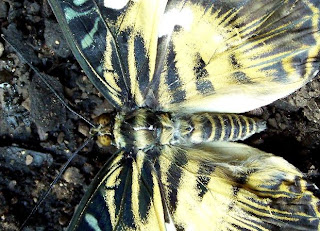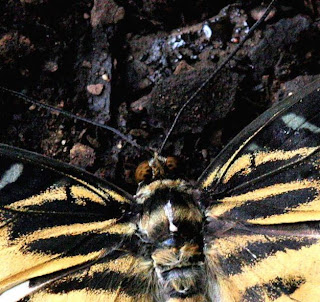Parthenos sylvia was scientifically described in 1775 by Pieter Cramer, a Dutch merchant of Spanish wool with a great interest in butterflies. The common name, clipper, is an allusion to the species’ white wing patches that look like the multiple billowing sails on the mighty sailing trade ships of Cramer's day. The white patches are located on the clipper's forewings and stand out against a background that varies in color.

The appearance of this Indo-Australian butterfly fluctuates across its broad geographic distribution. The wings may change in size and be blue, green, orange or brown, but the white patches remain unchanged in all of the 26 subspecies.

The Clipper butterfly exhibits various modes of protection from predators during its many stages of life. The lives of larval clippers greatly depend upon their meal choices and they prefer to eat the leaves of passion vines and moonseeds. The brown and black striped caterpillars covered with rows of purple spines absorb some of the poisonous organic substances of the plants to make themselves noxious to predators. The chrysalides, however, try to avoid being seen by predators in the first place and appear green or brown, depending on the subspecies.

Closely resembling a folded leaf, a clipper chrysalis is extremely difficult to spot in the forests they prefer to inhabit. Clipper adults are so brightly colored that they are easy to see, but protect themselves through unpredictability. Flying in erratic patterns through the tree canopy, clipper adults are difficult to attack or catch unless they stop to feed or rest.

Once captured, the clipper butterfly is relatively easy to breed and rear in a tropical butterfly enclosure. Sufficient quantities of its preferred larval food plant must be available, however, in order to appease the voracious caterpillars. Clipper butterflies are valued by collectors and wild individuals are marketed alongside cultured specimens from tropical butterfly ranches.
 The Clipper butterfly exhibits various modes of protection from predators during its many stages of life. The lives of larval clippers greatly depend upon their meal choices and they prefer to eat the leaves of passion vines and moonseeds. The brown and black striped caterpillars covered with rows of purple spines absorb some of the poisonous organic substances of the plants to make themselves noxious to predators. The chrysalides, however, try to avoid being seen by predators in the first place and appear green or brown, depending on the subspecies.
The Clipper butterfly exhibits various modes of protection from predators during its many stages of life. The lives of larval clippers greatly depend upon their meal choices and they prefer to eat the leaves of passion vines and moonseeds. The brown and black striped caterpillars covered with rows of purple spines absorb some of the poisonous organic substances of the plants to make themselves noxious to predators. The chrysalides, however, try to avoid being seen by predators in the first place and appear green or brown, depending on the subspecies. Closely resembling a folded leaf, a clipper chrysalis is extremely difficult to spot in the forests they prefer to inhabit. Clipper adults are so brightly colored that they are easy to see, but protect themselves through unpredictability. Flying in erratic patterns through the tree canopy, clipper adults are difficult to attack or catch unless they stop to feed or rest.
Closely resembling a folded leaf, a clipper chrysalis is extremely difficult to spot in the forests they prefer to inhabit. Clipper adults are so brightly colored that they are easy to see, but protect themselves through unpredictability. Flying in erratic patterns through the tree canopy, clipper adults are difficult to attack or catch unless they stop to feed or rest.
No comments:
Post a Comment